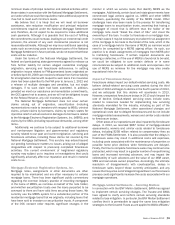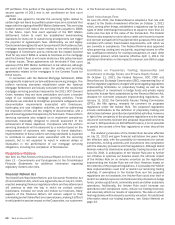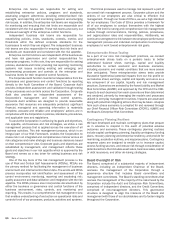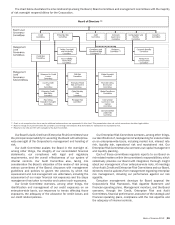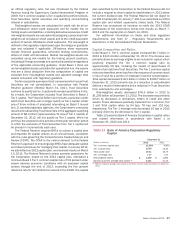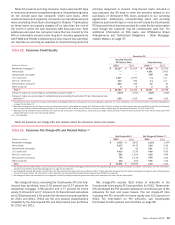Bank of America 2012 Annual Report Download - page 71
Download and view the complete annual report
Please find page 71 of the 2012 Bank of America annual report below. You can navigate through the pages in the report by either clicking on the pages listed below, or by using the keyword search tool below to find specific information within the annual report.
Bank of America 2012 69
In 2011, the Basel Committee on Banking Supervision (the
Basel Committee) issued proposed guidance on capital
requirements for global, systemically important financial
institutions, of which we are one, including the methodology for
measuring systemic importance, the additional capital required
(the SIFI buffer), and the arrangements by which the guidance will
be phased in. As proposed, the SIFI buffer would increase minimum
capital requirements for Tier 1 common capital from one percent
to 2.5 percent, and in certain circumstances, 3.5 percent. As of
December 31, 2012, we estimate our SIFI buffer would have been
1.5 percent, in line with the Financial Stability Board’s report,
“Update of Group of Global Systemically Important Banks,” issued
on November 1, 2012. U.S. banking regulators have not yet issued
proposed or final rules related to the SIFI buffer.
On December 20, 2011, the Federal Reserve issued proposed
rules to implement enhanced supervisory and prudential
requirements, and the early remediation requirements established
under the Financial Reform Act. The enhanced standards include
liquidity standards, requirements for overall risk management,
single-counterparty credit limits, stress test requirements and a
debt-to-equity limit for certain companies determined to pose a
threat to financial stability. The final rules, when adopted and fully
implemented, are likely to influence our regulatory capital and
liquidity planning process, and may impose additional operational
and compliance costs on us.
Preparing for the implementation of the new capital rules is a
top strategic priority, and we expect to comply with the final rules
when issued and effective. Based on Basel 2, the Market Risk
Final Rule and our current understanding of the Basel 3 Advanced
Approach issued by U.S. banking regulators, we estimated our
Basel 3 Advanced Approach Tier 1 common capital ratio, on a fully
phased-in basis, to be 9.25 percent at December 31, 2012. As
of December 31, 2012, we estimated that our Tier 1 common
capital would be $128.6 billion and total risk-weighted assets
would be $1,391 billion, also on a fully phased-in basis. This
assumes approval by U.S. banking regulators of our internal
analytical models, but does not include the benefit of the removal
of the surcharge applicable to the Comprehensive Risk Measure
(CRM). The CRM is used to determine the risk-weighted assets for
correlation trading positions. Under the Basel 3 NPRs, Tier 1
common capital includes components that exhibit heightened
sensitivity to changes in interest rates, such as the cumulative
change in the fair value of AFS debt securities and at least 10
percent of the fair value of MSRs recognized on the Corporation’s
Consolidated Balance Sheet.
Important differences between Basel 1 and Basel 3 include
capital deductions related to our MSRs, deferred tax assets and
defined benefit pension assets, and the inclusion of unrealized
gains and losses on debt and equity securities recognized in
accumulated OCI, each of which will be impacted by future changes
in interest rates, overall earnings performance or other Corporate
actions. Our estimates under the Basel 3 Advanced Approach will
be refined over time as a result of further rulemaking or clarification
by U.S. banking regulators and as our understanding and
interpretation of the rules evolve.
Basel 3 regulatory capital metrics are non-GAAP measures until
they are fully adopted and required by U.S. banking regulators.
Table 15 presents a reconciliation of our Basel 1 Tier 1 common
capital and risk-weighted assets to our Basel 3 estimates at
December 31, 2012, assuming fully phased-in measures
according to the Basel 3 Advanced Approach.
For additional information regarding Basel 2, the Market Risk
Final Rule, Basel 3 and other proposed regulatory capital changes,
see Note 17 – Regulatory Requirements and Restrictions to the
Consolidated Financial Statements.
Table 15 Basel 1 to Basel 3 (fully phased-in) Reconciliation
December 31
(Dollars in millions) 2012
Regulatory capital – Basel 1 to Basel 3 (fully phased-in)
Basel 1 Tier 1 capital $ 155,461
Deduction of qualifying preferred stock and trust preferred securities (22,058)
Basel 1 Tier 1 common capital 133,403
Deduction of defined benefit pension assets (737)
Change in deferred tax assets and threshold deductions (deferred tax asset temporary differences, MSRs and significant investments) (3,020)
Change in all other deductions, net (1,020)
Basel 3 (fully phased-in) Tier 1 common capital $ 128,626
Risk-weighted assets – Basel 1 to Basel 3 (fully phased-in)
Basel 1 risk-weighted assets $ 1,205,976
Net change in credit and other risk-weighted assets 103,085
Increase due to Market Risk Final Rule 81,811
Basel 3 (fully phased-in) risk-weighted assets $ 1,390,872
Tier 1 common capital ratios
Basel 1 11.06%
Basel 3 (fully phased-in) 9.25


